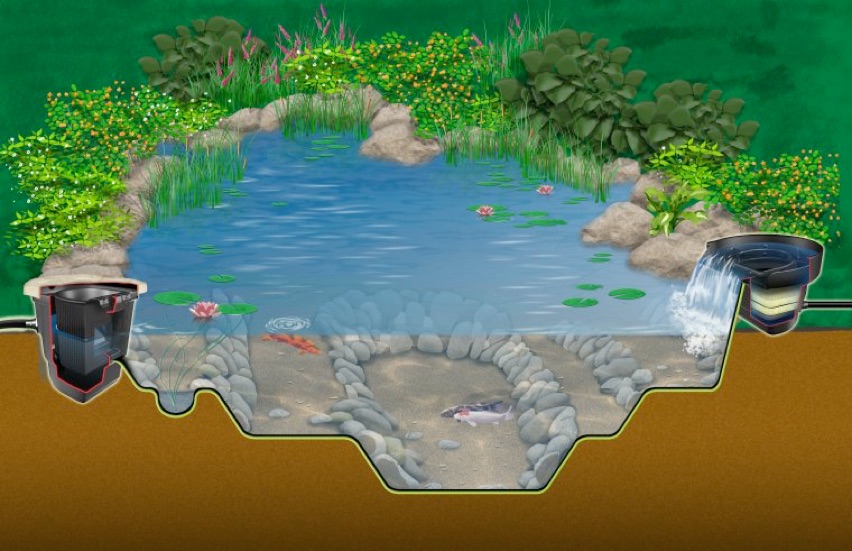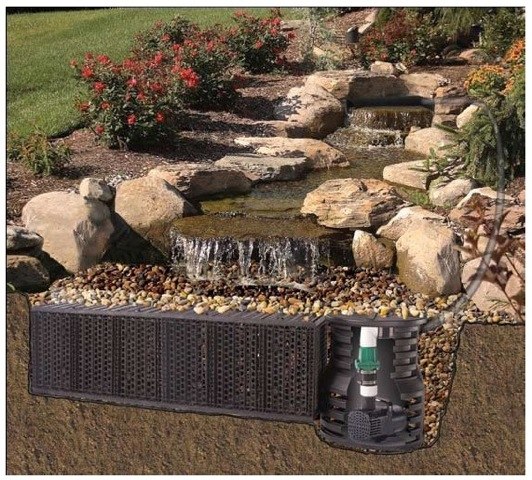Frequently Asked Questions and Facts
About Water Features
Frequently Asked Questions and Facts
About Water Features
What kind of water feature do I want?
You’re taking the plunge. You want a water feature in your landscape but aren’t sure where to begin. Start by asking yourself, “What made me think about adding a water feature in the first place?”
Maybe you were on vacation and enjoyed lounging by the lake or ocean. Perhaps you visited a shopping center and were drawn to the sound and beauty of a fountain where you could rest your weary feet. Or maybe you were thumbing through the pages of a magazine and saw photos of children interacting with fish in a pond and you envisioned your own family enjoying time spent with Mother Nature.
Your intent for adding water to your landscape will be the first step in helping you determine what type of water feature to install. If you envision hours of interaction with nature, then a full-fledged water garden with fish and plants is in order. If you simply want to enjoy the sound of running water while sitting on the deck or patio, then a pondless waterfall will suit your needs. Or maybe you’re thinking of enhancing your home’s curb appeal, in which case a stylish fountain near the entrance to your home will do the trick.
Your space and budget will also define the type of water feature that’s best for your lifestyle. A fountain or pondless waterfall can be tucked into any corner of your garden, whether it’s located at the heart of an English knot garden, or situated in the midst of perennial flowers for birds and butterflies to enjoy. Water gardens with fish and plants can be small or expansive, with multiple waterfalls and streams added.
The range of options for adding a water feature to your landscape is almost limitless. Whether you’re spending a few hundred dollars or tens of thousands of dollars, you’ll be sure to find the right solution for refreshing your landscape with a beautiful water feature.
What is an ecosystem pond?
Ecosystem ponds include a natural balance of fish, plants, aeration, filtration, and rocks and gravel. All components interact naturally with one another helping to create and maintain a sustainable, low-maintenance ecosystem pond. Each pond is unique in its design and creation, whether large or small. An Ecosystem Pond built by Rocky Mountain WaterScape will contain a biological filter and pond skimmer to form a unique filtration system resulting in a crystal clear pond.

What is a pondless® waterfall?
Pondless waterfalls are simply a recirculating waterfall or stream without the presence of a pond. It is an ideal option for families with small children, you can add the sight and sound of running water into your landscape without safety concerns for your little ones. Pondless waterfalls can be tucked into any corner of your landscape. They are built with a basin that is lined, filled with aquablox and rock that houses the pump vault. This basin stores all the necessary water to operate the stream and waterfalls without building a pond. Because there is no pond, this type of water feature requires almost no maintenance! It can even be turned off for the winter or run on a timer. See X-section of a pondless waterfall below:

How do I control algae?
A new string algae control device manufactured by Aquascape is called the IonGen. It is a water clarifier for ponds and other decorative water features. It drastically reduces pond maintenance and provides crystal clear water without the use of chemicals. A microprocessor inside the IonGen causes the outermost atoms of copper, silver, and zinc to lose an electron, creating a positive ion.The positive ion attempts to flow from one of the probe's bars to the other and is swept away by the flow of water where the ion can begin to treat the water. The metal alloys in the probe are scientifically blended and tested to produce maximum results. The IonGen System is safe for fish and plants and is not toxic to any animals that may drink from the pond.
Can I keep my fish in my pond over the winter?
Here are a few tips to help your pond dwellers survive the Colorado winters. Moving water will not freeze, so if you have shut your pump off for the winter, we can install an aerator for the fish, which gives them oxygen and keeps the water running. Some people like to add a stock heater, too. Stop feeding them when the water temperature gets to 50° so they can go into a semi dormant state and begin feeding them in the spring once the temperature returns to 50°.
20 Myths About Ponds Exposed:
I want my pond located in the lowest part of my yard!
This is probably the worst location for your investment because of the run-off that can creep its way into your pond. When your pond is positioned near your house, you can take in the beauty and tranquility of your pond when entertaining friends or lounging on your deck.
You can use a timer on your pond!
Not true! Your pond is a living, breathing ecosystem that needs constant oxygen, just like the human race. If you shut your system down at night, then you can never have sufficient growth of beneficial bacteria to fight algae blooms, and your finned friends will have a hard time breathing. You can shut down a Pondless® Waterfall system, however, whenever you’d like because plants and fish are not depending on the circulation for oxygen and nutrients.
It’s necessary to drain and clean your pond regularly.
If you decide to work in harmony with Mother Nature, using the five-part recipe (a natural balance of fish, plants, aeration, filtration, and rocks and gravel), instead of doing battle with her, then draining and cleaning your pond should take place only once a year (at most). Clean-outs should occur in the spring, before the weather gets warm and the bacteria has an opportunity to set up.
Bottom drains work best if you have koi.
If you avoid making your pond any deeper than two feet, there is very little difference in the oxygen levels at the surface and at the bottom of the pond.
The more filtration,the better the pond.
Believe or not, you can over-filter a pond. Tight filter pads in your skimmer pick up the smallest particles of debris, causing you to be cleaning the filtering mechanism out constantly. Fish in the wild certainly don’t swim around in bottled water. If you can see a dime on the bottom of the pond, then the water clarity is just right for your fish and filtering past that create headaches, not eliminate them.
You can’t be a koi hobbyist and a water gardener.
Not true! You can raise koi and have a beautiful water garden. The koi can grow up to be just as beautiful and just as healthy as they are in traditional koi ponds – and you’ll love them just as much!
High tech is the solution to controlling Mother Nature.
More than anything else, being observant and learning from Mother Nature is what it takes to be a water gardener. Whatever she does naturally is what you should be doing in your pond.
Predators will eat all of your fish!
Raccoons generally won’t swim. That’s not to say they never swim, or couldn’t stand on the side of your pond and take a paw swipe or two at your fish. Fortunately, most fish will swim to a deeper, more protected part of the pond when a predator is threatening them. The one predator with legitimate credentials is the blue heron. The Scarecrow, a motion-sensing sprinkler that can be set up alongside your pond, ready to fire a steady stream of water at a heron, has had some degree of success in warding off these curious critters. Plenty of lily pads give them some protection and will work to minimize attracting a heron in the first place. Other protection measures include a cave-like structure that can be built in during the pond’s excavation, or if you already have a pond, they can be added with a little pond remodeling. Crevices, or miniature caves, can also be created within the rock walls of your pond.
The presence of rocks and gravel make it difficult to clean your pond.
Rocks and gravel offer a natural place for aerobic bacteria to colonize and set up housekeeping. This bacteria breaks down the fish waste and debris that would otherwise accumulate in the pond and turn into sludge. Regardless of your pond’s location (i.e. close to trees and loads of leaves), or how many fish you have in it, you’ll find that having rocks and gravel in your pond not only makes it look better, but it makes it healthier as well. So contrary to the myth, having rocks and gravel on the bottom of your pond actually allows Mother Nature to clean up after herself.
UV lights such as those in the UltraKlear™ UVC are the best way to keep your pond water clear.
UV clarifiers are one of the ways to keep your pond water clear, but certainly not the only way, and arguably not the natural way. The fact of the matter is that if you have a pond that’s naturally balanced, in which the aquatic circle of life is rotating the way that Mother Nature intended, you don’t need UVC at all. A naturally balanced pond is a low maintenance pond because Mother Nature is doing the maintenance work for you.
Your pond must be at least three feet deep in order to keep koi.
There are thousands of two-foot deep ponds around the country, full of happy and healthy koi. You see, the water in a two-foot deep pond will generally only freeze eight inches down, even in the coldest of climates, because of the insulating qualities of the earth that surrounds the pond. Also, more digging means more work, more water to fill the pond, and more additives to treat algae and fish illnesses.
Koi can’t be kept in a pond that also contains plants.
In a naturally balanced ecosystem, koi and plants complement and need one another. In nature, fish feed on plants. As a result, the fish produce waste, which is broken down by aerobic bacteria on the bottom of your pond, which, in turn, is used as fertilizer by the plants to grow and produce more natural fish food. It’s known as the circle of life, and to imply that koi and plants shouldn’t co-exist is to ignore nature. On the other hand, you have to have a sufficient volume of plants to accommodate the koi too. In the naturally balanced pond, proportionality is always a key ingredient to success.
You have to bring your fish inside for the winter.
Fish do fine during the coldest of winters as long as you give them two feet of water to swim in, oxygenate the water, and keep a hole in the ice with a bubbler, allowing the naturally produced gasses to escape from under the ice.
Your pond water must be tested on a daily basis.
Mother Nature never tests her water, and her ecosystem does just fine. A well conceived, naturally balanced water garden normally requires no testing either.
A pond in your backyard means you will have a lot of mosquitoes.
Mosquitoes will generally only lay their eggs in still, stagnant water. If the mosquitoes happen to lay eggs in your pond and the mosquito larvae hatch, the fish in your pond will consider them a treat and will pick them off the water’s surface with great enthusiasm.
You cannot have a pond in an area where there are a lot of trees.
Yes, you will have more leaves in your pond in the fall but, by the same token, the shade provided by the tree(s) will help minimize the algae bloom in the summer. Furthermore, if you have a skimmer sucking the top quarter inch of water off the top of your pond, it will pull most of the leaves and related debris into the skimmer net. This takes about 30 seconds to empty, and it can be a daily task in the fall if your pond is close to trees.
You can’t have koi in a pond that also has rocks and gravel.
Koi are actually just a fancy variety of carp, and all carp are bottom feeders. They love to swim along the bottom and scavenge everything that is available on and in-between the rocks.
It’s okay to use chemicals in your pond.
Products like algaecide (copper sulfate), de-chlorinator (sodium thiosulfate), and fish antibiotics are commonly used as quick-fix solutions to balance related problems. In the end, your best bet is to attack the root cause of the problem and make sure that you have a naturally-balanced pond that allows Mother Nature to take care of all the maintenance issues.
Having a pond may decrease the value of your home!
Everyone knows when it comes to the resale value of your home, a swimming pool can be deadly. However, in the opinion of some real estate agents, ponds can be a great addition to your home that might even pay dividends. With water features becoming more and more popular, you can bet that the demand for them will get even bigger!
I have liability or safety concerns!
It’s natural to have these thoughts and concerns, but it is important to remember that a professionally-installed water garden has steps leading into the pond. The first shelf is only ankle high once the gravel is laid down. The next shelf is up to your knee, while the smallest area in the bottom is just above your knee, so it is not constructed like a swimming pool. We do recommend that you make your neighbors aware of the water garden and educate your own children and friends about the safety of any body of water. If liability is a true concern, consider the option of a Pondless® Waterfall.



303-666-5430